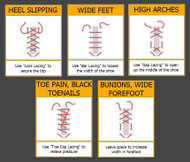How to Avoid Foot Issues When Playing Pickleball
Pickleball fever is here! It’s more than just a sport; it's a passion, a community, a competitive arena where players chase, volley, and dive, pushing their limits. But, as we know, every pickleball warrior's best ally, apart from their paddle, is their feet. How you treat them makes all the difference between an epic game and one interrupted by pain. Enter the world of shoelace techniques - the unsung hero of foot support. Let's dive deep into how you can tweak your lacing and supercharge your pickleball gameplay.
A Closer Look at Your Foot’s Blueprint
The human foot is an architectural marvel. Housing over 26 bones, myriad joints, and a complex network of tendons, ligaments, and soft tissues, it carries our entire body weight, helping us sprint, pivot, jump, and, most importantly, dominate the pickleball court. With great power comes great responsibility. We must understand our feet well to support them appropriately.
When Feet Talk: Common Foot Woes in Pickleball
Pickleball's dynamic nature means our feet are constantly at work. Sudden direction changes, quick sprints, and jumps can sometimes result in injuries. You might face issues ranging from sprained ankles and stress fractures to tendon strains. The type of shoes you wear, their fit, and yes, the way they’re laced, can play a pivotal role in either preventing or exacerbating these injuries.
The Game-Changing Role of Shoe Lacing Techniques
Did you know the way you tie those shoelaces can significantly influence foot health and game performance? It's not just about keeping your shoes on; it's about ensuring that every part of your foot gets the right support, that pressure is distributed evenly, and that you have maximum stability on the court. Proper shoe lacing can indeed be your secret weapon!
Unlocking the Top 5 Shoe Lacing Techniques for Pickleball Enthusiasts
1. The Arch Lace Technique
For those with prominent arches, the mid-foot can often feel strained. Using this method: Start lacing as usual but when you hit mid-foot, skip a couple of eyelets. Continue to lace up to the top. This technique creates a pocket of relief for the arch, reducing pressure and enhancing comfort.
2. Heel Lace Technique
A sore heel can massively impact your pickleball game. Here’s a lacing method to counter that: Initiate the lacing from the base of the shoe. As you progress, especially near the ankle, create a 'lock' by looping the laces through the same eyelet before crossing over. This ensures a snug fit, stabilizing the heel and minimizing friction.
3. Comfort Lace Technique
Ideal for those nursing toe injuries or simply wanting more toe space: Begin lacing from the bottom. As you near the shoe’s upper region, lace more loosely, allowing your toes to breathe easy.
4. Broad Base Lace Technique
For those gifted with wider feet, this method ensures you don’t feel constricted: Bypass the bottommost eyelets completely. Start lacing from the second set and continue upwards, ensuring even tension.
5. General Lace Technique
For the all-rounder comfort seekers: Adopt the classic criss-cross lacing. Keep the tension even, ensuring no part feels too tight.
Pro Tips to Play Pickleball without Foot Pains
Beyond lacing, here are some golden nuggets to keep your feet happy:
Right Shoe Selection: Always pick shoes tailored for pickleball. They should offer grip, cushioning, and flexibility.
Regular Rotation: Rotate between two pairs of shoes. This ensures they don’t wear out quickly and maintain optimal cushioning.
Post-Game Care: After an intense game, pamper your feet. Stretch them out, give them a quick massage, and if you feel any unusual pain, don't ignore it.
Pickleball is a game of agility, strategy, and passion. But without the right foot support, your game can suffer. By understanding your foot’s needs and using the ideal lacing technique, you’re not just prioritizing comfort, but also unlocking your best performance. Remember, in pickleball, as in life, it’s the little details that count.
Frequently Asked Questions
Q: How often should I replace my shoes for pickleball?
A: Consider replacing your shoes every 6-8 months, depending on the frequency of play. Regularly check for signs of wear and tear.
Q: Are insoles a good option for added foot support?
A: Absolutely! Customized insoles can offer additional arch support and cushioning. However, always consult a foot specialist before making a choice.
Q: Is it normal for my feet to hurt after a long game?
A: While some fatigue is natural, persistent or sharp pain isn’t. Always consult a specialist if you experience consistent discomfort. Pickleball is as much about the rush of the game as it is about taking care of your body. With the right shoe lacing techniques, you’re geared up for many more smashes, serves, and game-winning shots. Lace up, step out, and let the games begin!
Share Product:
SHARE THIS:


